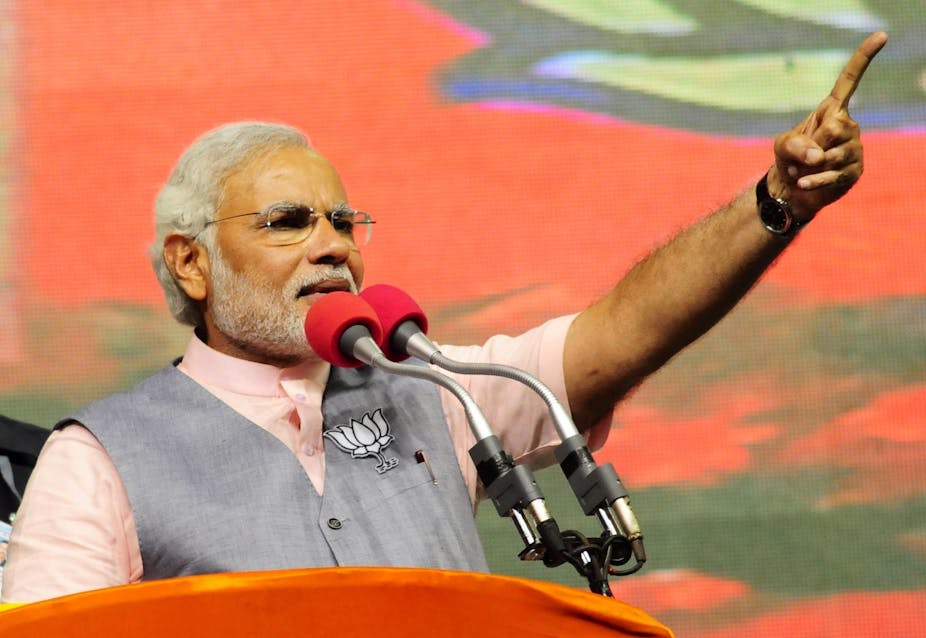India’s new prime minister Narendra Modi has signalled a commitment to continue his nation’s “Look East” foreign policy in a world of growing Asian influence.
However, Modi may find it difficult to define a policy when India is yet to define what it wants out of it.
What is the ‘Look East’ policy?
India’s burgeoning links with countries in east and southeast Asia, along with its expanding influence in the Asia-Pacific and Indian Ocean regions since the 1990s, has been categorised as a collective Look East policy. The policy has been scrutinised and analysed from all ends of the spectrum.
Over the last two decades, the Look East policy has received official status and has been mentioned in almost all public documents issued by the concerned departments and ministries. It evolved over time from what in the 1990s was initially a government directed initiative to improve India’s economic links with the “tiger economies” in southeast Asia.
Sometimes referred to as being in “phases two and three”, the policy now aims to:
- combine economics with strategic concerns – primarily projected through an expanding Indian navy;
- rework India’s relations with key Asian powers in southeast Asia and east Asia with an assertive China being the key concern; and
- link up the development model for India’s strategically important but economically vulnerable northeast region within the Look East policy rhetoric.
Japan: everyone’s best friend?
The policy has involved a series of engagements at bilateral and multilateral levels with India’s inclusion in various regional organisations. Bilaterally, countries like Mauritius, Singapore and Japan now figure among the top ten sources of foreign direct investment to India.
Though countries such as South Korea and Japan were not originally included in the Look East policy, potential for these linkages has been generated by recent strategic initiatives and a common fear of an increasingly assertive China involved in territorial and maritime disputes with countries like Vietnam, the Philippines and even Japan.
The swearing in of the new government in India has generated hopes of deepening ties between Japan and India. This is being attributed to a perceived closeness between Modi and his Japanese counterpart Shinzo Abe. Abe, as per media reports, follows three people on Twitter, and one of them is Modi.
Growing convergence between Indian and Japanese strategic interests and concerns in Asia show good signs for a comprehensive Indo-Japanese partnership. There was a considerable gap in relations after Indian nuclear tests in 1998.
So, is Look East working?
Given the range of complexities involved in Look East policymaking, it’s little wonder that several critics often find it to be incoherent and piecemeal, rather than being a well planned and comprehensive initiative.
There is, however, a historical aspect to the policy which evolved during pre-colonial and colonial periods. Greater awareness of the history of the approach among policymakers would help them contextualise present developments, leading to more effective policymaking.
One example of this is the need on the part of Indian policymakers to avoid any direct reference to the antiquated attempts to “Indianise” southeast Asia which were popular in pre-colonial times. This view hurt regional sentiments, and instead the rhetoric of “acculturation in the region” should be adopted.
The undefined nature of the Look East policy actually results from the fact that Indian decision-makers are yet to come to an agreement as to the real purpose and objective of the policy. It has been argued that the policy is continuously affected by three broad “visions”:
- The projection of Look East as an external security trajectory;
- A strategy of economic cooperation; and
- A community vision aimed at abolishing sub-nationalism in India’s northeast and other connected regions.
The Indian desire for a “best of all” approach actually results in uneasy compromises, awkward bottlenecks and policy indecision.
The success of India’s Look East policy ultimately depends on a set of multiple domestic, regional and global factors as it enters into a crucial phase of transition – some of which remain beyond the control of policymakers.

